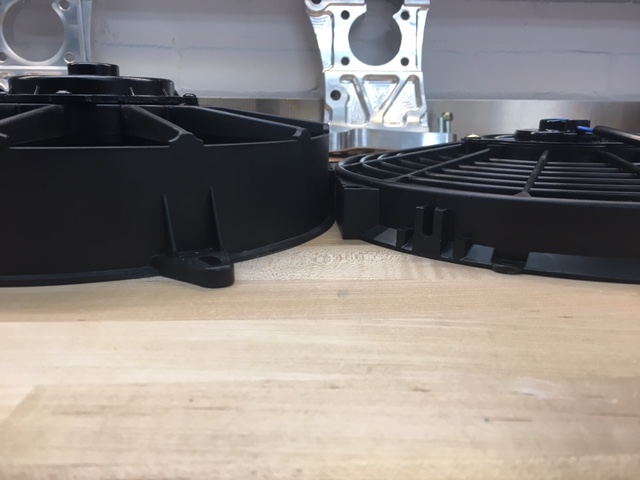Cooling is a challenge for a high-HP, mid-engine car. This is exacerbated by the SL-C's extremely low, front-end profile which makes the car very aerodynamic, but doesn't leave a lot of room for a radiator. In fact, the radiator is sloped 55 degrees just to achieve a core area (i.e., the fins that act as a heat exchanger) of 24" x 11.5".
When driving, air flows through the entire core. However, when stopped air only flows through the area directly in front of the fans. Generally speaking this is a bad idea for any car that is ever going to idle or sit in traffic. To get around this issue, most OEM cars utilize a fan shroud which, when properly implemented, results in air being forced through the entire core. The downside is that at speeds at 20-30 MPH the shroud restricts air flow and can cause overheating while driving. This can be solved by adding one or more flaps which are forced closed by the vacuum created by the fans pulling air across the shroud (assuming the shroud is properly sealed) and forced open by wind pressure as the car picks up speed.
The kit ships with a really nice custom-made aluminum radiator, two decent fans (I believe 1,200 CFM each) and no shroud. SL-C builders disagree whether or not a shroud should be used. I spoke with Chuck at Superior Radiator who manufactures the radiator and he suggested a shroud and upgraded fans, all of which I bought from him. The shroud is made of 0.65" aluminum and the fans are much larger than the ones that came with the kit (in the two pictures below, the new fan is on the left).
The old fans are rated at 1,300 CFM whereas the new ones are rated at 2,000 CFM. Chuck indicated that they are more of a wholesale item with a minimum purchase of 100 units so I don't have a part number.
He didn't think that I'd need flaps, but I decided to add two just to be safe. I wasn't sure what to make them out of so I ordered two from Summit Racing. They were replacement parts and as such had no specifications. The SPAL Automotive ($1.31) and Be Cool ($6.99) flaps were indecipherable. Fortunately, at 3.3" x 2" they were a perfect fit. There is nothing special about them. They're made out of floppy 0.4" rubber and have three molded mounting spikes which I cut off. So, it's trivial to make your own.
Here are the high-level modifications I made. The fans were a little too close together and the lip of the right one was sitting on top of the lip of the left one which result in a poor seal between the fan and the shroud. To remove the fans I drilled the rivets holding them in place...
I will have temperature sensors on both the cooling and AC pipes and I'm in the process of figuring out how to control the fans with the MoTeC ECU and Power Distribution Modules (PDMs). Each fan draws 17 amps when running and 23 amps when starting up. This gives me two options:
- Use a single 8-amp output to drive an external relay
- Use a 20-amp output for each fan
MoTeC: Coolant Temp Threshold & Hysteresis
The advantage to the first option is that it only uses one small output. On the downside, it requires a relay (more wiring and a potential failure point) and results in a bang-bang control loop (i.e., either all on or all off). Fortunately, the MoTeC configuration software enables you to configure both a temperature-based threshold and hysteresis (see image).
The downside of the second option is that is consumes two large outputs. However it has significant benefits; it requires no external parts and the fans can be individually controlled via PWM. In addition, the 20 amp circuit can handle startup spikes up to 115 amp as well as a "digital" fuse which can be configured in one-amp increments with multiple auto-reset options. While bang-bang circuits work fine in most cars, 2,000 CFM is a pretty big bang and PWM provides fine-grained control via software.
I'm happy with the shroud, but if I had it to do over again I would ask Chuck to not mount the fans (no need to drill them out), cut the flap holes (less work) and make the shroud a little deeper (just to be on the safe side).







